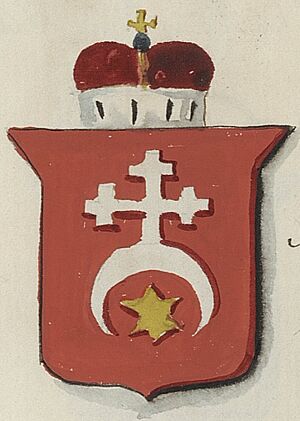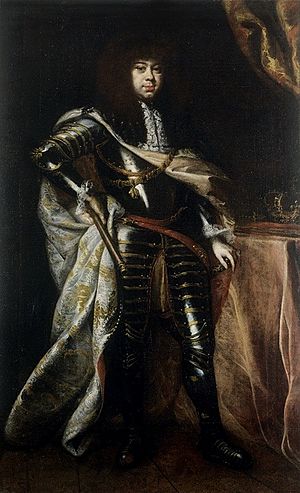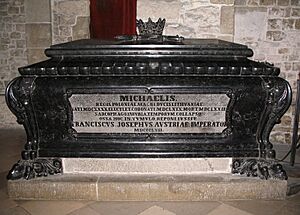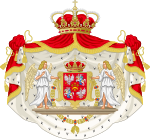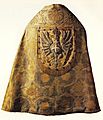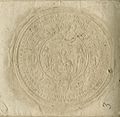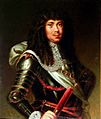Michał Korybut Wiśniowiecki facts for kids
Quick facts for kids Michael I |
|
|---|---|

Portrait by Daniel Schultz, 1670
|
|
| King of Poland Grand Duke of Lithuania |
|
| Reign | 19 June 1669 – 10 November 1673 |
| Coronation | 29 September 1669 |
| Predecessor | John II Casimir Vasa |
| Successor | John III Sobieski |
| Born | Michał Tomasz Wiśniowiecki 31 May 1640 Biały Kamień, Polish–Lithuanian Commonwealth |
| Died | 10 November 1673 (aged 33) Lwów, Polish–Lithuanian Commonwealth |
| Burial | 31 January 1676 Wawel Cathedral, Kraków |
| Spouse | Eleonora Maria of Austria |
| House | Wiśniowiecki |
| Father | Jeremi Wiśniowiecki |
| Mother | Gryzelda Konstancja Zamoyska |
| Religion | Roman Catholicism |
| Signature | |
Michael I (born Michał Korybut Wiśniowiecki, 31 May 1640 – 10 November 1673) was the ruler of the Polish–Lithuanian Commonwealth. He served as King of Poland and Grand Duke of Lithuania from 1669 until his death in 1673.
Michael was chosen as king partly because of his father, Prince Jeremi Wiśniowiecki. His father was a powerful noble who helped stop the Cossacks in eastern Poland. After Michael's early death, his successor, John III Sobieski, won an important battle in 1673. This victory helped reverse some of the problems from Michael's rule.
In 1670, Michael I married Eleonora Maria of Austria. She was the daughter of Ferdinand III, Holy Roman Emperor.
Contents
His Early Life
Michael was the son of Jeremi Wiśniowiecki and Gryzelda Konstancja Zamoyska. His parents likely met in September 1637 in Warsaw. This was during the crowning of Cecilia Renata of Austria, the Queen of Poland. They got engaged in February 1638.
Michael was probably born on May 31, 1640, in the village of Biały Kamień. He was then taken to Zamość. He spent his first two years there with his grandmother. In 1642, his mother took him to Lubny. During the Khmelnytsky Uprising, his family had to leave their home. They first settled in Wiśniowiec before arriving in Zamość in 1648.
Michael's father, Jeremi Wiśniowiecki, died in 1651. Most of his family's lands were controlled by Cossacks or Russians. From 1651 to 1655, young Michael was cared for by Karol Ferdynand Vasa. He was a bishop in Poland. After the bishop died in 1655, Michael was taken in by his rich uncle, Jan Zamoyski. His uncle paid for his education. Around mid-1655, Michael went to the court of King John II Casimir.
When Sweden invaded Poland, Michael fled with the royal court. They went to Głogówek. In November 1655, the king asked him to study at a Jesuit college in Nysa. He stayed there until March 1656.
In mid-1656, Michael began studying at Charles University in Prague. He returned to Poland in June 1660. Soon after, he traveled to Dresden and Vienna. There he met Empress Eleonora Gonzaga. He also saw his future wife, Eleanor of Austria, who was a child then. On this trip, Michael became better at languages. He spoke Latin, German, Italian, French. He likely also knew Tatar and Turkish.
In 1663, Michael fought in the Russo-Polish War. During the Lubomirski Rebellion, he stayed loyal to the king.
Becoming King
On September 16, 1668, King John II Casimir gave up the Polish throne. He left the country to live in France. This meant a new election was needed. A bishop named Andrzej Olszowski suggested Michael Korybut as a candidate. The Polish nobility supported Wiśniowiecki. They felt that a less experienced prince would not threaten their rights. These rights were part of the Golden Liberty.
The election of 1669 took place in May and June. Michael Korybut Wiśniowiecki was chosen as King of Poland and Grand Duke of Lithuania on June 19. He became known as Michael I. Most nobles voted for him because they wanted a Polish king. Wiśniowiecki won 11,271 votes. He was crowned on September 29, 1669, in Kraków.
His election was immediately opposed by a group that favored France. This group was led by the Primate of Poland, Mikołaj Prazmowski, and Crown Hetman John Sobieski.
On February 27, 1670, Michael I married Austrian princess Eleanor. The ceremony was led by a Papal Nuncio. Primate Prazmowski refused to attend. The celebration happened at the Denhoff Palace.
Challenges as King
After the 1669 election, the Commonwealth was split into two groups. One group favored France, and the other supported the king. The pro-French group had many powerful members. These included Primate Prazmowski and Hetman Sobieski.
In November 1669, the French group stopped the Coronation Sejm. They hoped to remove Michael and elect a French prince. In 1670, the fight moved to local meetings. Nobles demanded a lawsuit against Hetman Sobieski. To defend him, Sobieski's soldiers formed a Confederation.
To make things worse, the Commonwealth faced a constant threat from the Turks. In 1671, the king supported a rebellion. A group of soldiers left Volhynia, leaving it unprotected. King Michael ordered these soldiers to stay in a rich area. He paid them their salaries. Meanwhile, Sobieski and his soldiers did not get paid.
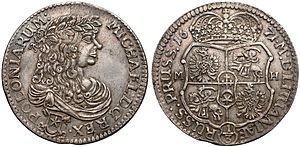
In 1672, the Ottoman Empire declared war. The Polish–Ottoman War of 1672–76 began. Despite this, Poland was still in chaos. There was a danger of a civil war. The nobles formed a confederation. They demanded that Primate Prazmowski be removed. They also took property from Hetman Sobieski's family. In November 1672, Lithuanian soldiers also formed a confederation. They supported the first group. In response, Sobieski's soldiers formed their own confederation. John Sobieski and his troops went to Łowicz to meet Primate Prazmowski.
Negotiations between the two sides were held. The Ottoman Sultan Mehmed IV sent a letter to Warsaw. He demanded that Poland fully obey the Ottomans. This made the Poles very angry. But because of the chaos in the Commonwealth, both sides agreed in March 1672.
War with the Ottoman Empire
In June 1672, a huge Ottoman army of 100,000 soldiers attacked Kamieniec Podolski. The city gave up after 26 days. The invaders then moved towards Lwów. Lwów paid money to avoid being attacked. Mounted Crimean Tatar units went as far as Hrubieszów and Jasło.
In October 1672, Hetman John Sobieski tried to stop the invaders. He defeated them in several battles. Meanwhile, the Treaty of Buchach was signed on October 18. In this treaty, the king gave Podolia to the Ottomans. He also agreed to pay a yearly tribute. This made the powerful Polish-Lithuanian Commonwealth weaker against the Turks.
Soon after, Michael I began preparing for a new war against the Ottomans. On October 8, 1673, about 40,000 Polish soldiers gathered near Złoczów. They had 50 cannons. Because of his poor health, the king gave command of the army to Sobieski. The Poles marched south towards Chocim.
His Death and Legacy
King Michael I Korybut died in Lwów on November 10, 1673. His early death might have been caused by severe food poisoning. However, there were rumors that he was murdered by generals who were angry about the Commonwealth losing power.
The day after Michael's death, John Sobieski won the Battle of Chocim. This victory helped get back some of what was lost during Michael I's reign. On May 19, 1674, Hetman John Sobieski was chosen as the new king.
After his funeral, Michael's heart was buried in a monastery in Warsaw. His body was buried in Wawel Cathedral in Kraków on January 31, 1676. This was the same day John Sobieski was crowned as John III.
Michael's time as king is not seen as very successful. His ability to rule was hurt by the fighting groups in Poland. Even with his father's military fame, Michael lost the first part of the Polish–Ottoman War of 1672–1676.
Royal Titles
Michael I had a very long official title in Latin. It showed all the lands he ruled.
In English, his title meant: Michael I, by the Grace of God, King of Poland, Grand Duke of Lithuania, Ruthenia, Prussia, Masovia, Samogitia, Livonia, Smolensk, Kiev, Volhynia, Podolia, Podlaskie, Severia and Chernihiv, etc.
Images for kids
-
King Michael I Korybut by Jan Matejko
-
Clementinum in Prague, where he studied
-
Battle of Chocim on 11 November 1673
-
Seal of Grand Duchy of Lithuania (1671), used during Michael's reign
See also
 In Spanish: Miguel Korybut Wiśniowiecki para niños
In Spanish: Miguel Korybut Wiśniowiecki para niños
- History of Poland (1569–1795)
- Wiśniowiecki family


